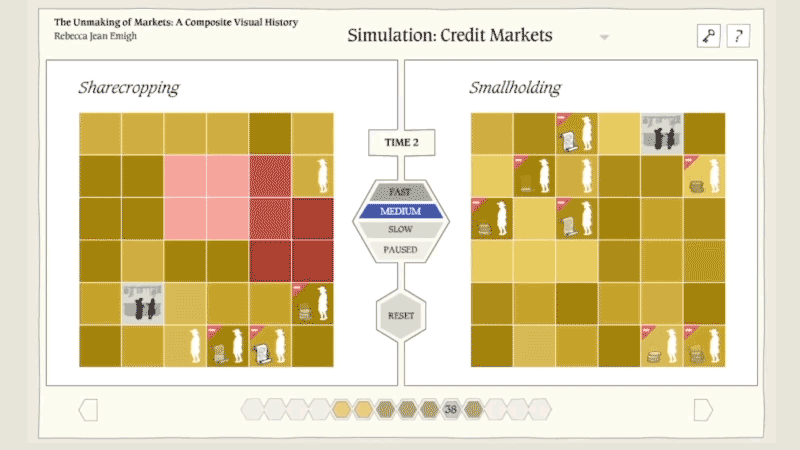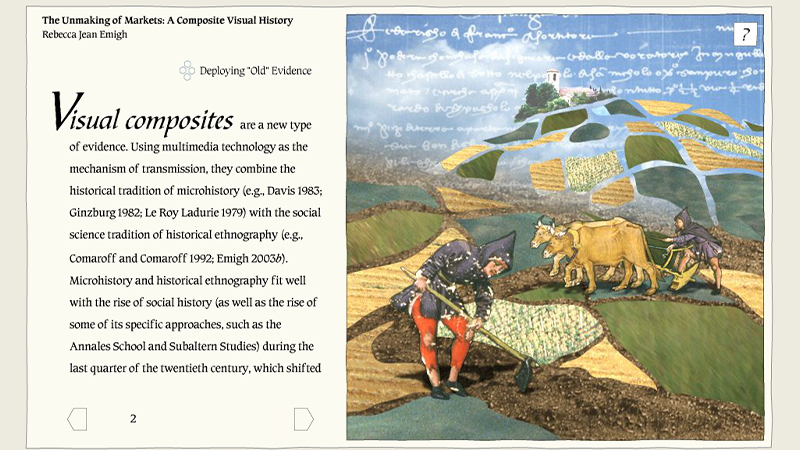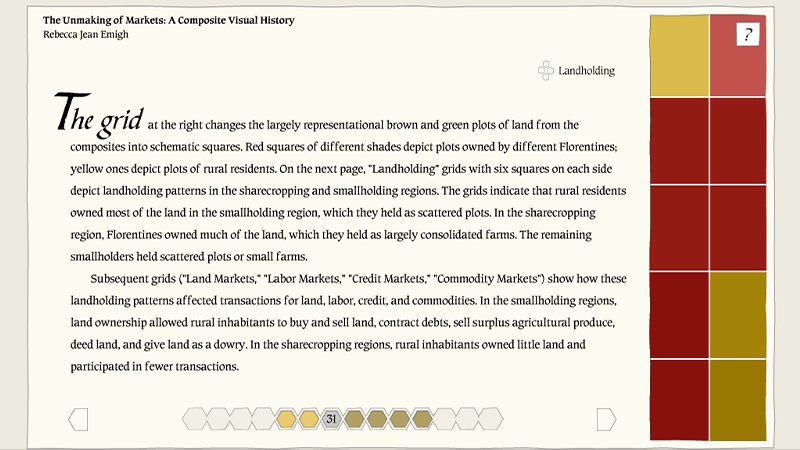Editor's Introduction
"The past is not always prologue. And backward glances that are filtered through sedimented layers of history too often lead us to view them as leading inevitably up to the present. How can we understand evidence that defies conventional wisdom and seamless historical trajectories? Rebecca Emigh's [project] suggests a provocative approach to visualizing the anomalous economic and social evolution of 15th century Tuscany that melds traditional research with multimedia presentation. The project is the result of a collaboration between sociologist Rebecca Emigh and designer Erik Loyer. Through their work on this project, Loyer and Emigh developed a system of simulations and composites to articulate a historical argument that defies the logic of inevitability usually associated with theories of capitalist economic development. Like several other projects in this issue of Vectors, including Virtual Vaudeville and The Menorah of Fang Bang Lu, The Unmaking of Markets is primarily interested in microhistory, i.e. the investigation of people's everyday lives – as a counterpoint to the grand historical narratives within which the stories of ordinary people are frequently lost. However, a related but more extreme set of challenges faces historians of the 15th century than those of the 19th or 20th centuries with regard to evidence. Emigh and Loyer's work must fill in large historical gaps between contemporary photographs and a handful of landscape paintings and landholding documents from the 15th century. The Unmaking of Markets attempts to bring these artifacts of ethnographic research to life using strategies of dynamic multimedia visualization. A key goal of the project was to develop a model of visualization that is recognizable to researchers in the social sciences who are accustomed to dealing with abstract data composites. Unmaking Markets thus functions as both a visualization of Emigh's historical argument and a space within which to explore a range of primary documents and visual artifacts." – Tara McPherson and Steve Anderson, Vectors Editors
Author's Statement
"Despite the inherent painfulness of the peer-review process, it fruitfully motivated this piece. An anonymous reviewer commented that my print article (Emigh 2003b) was tedious and boring. Yet, audiences of my oral PowerPoint presentations with similar material rarely appeared annoyed or sleepy. From this difference, I concluded that the visual presentation evoked a time and place, helping the audience to imagine an unfamiliar history that the text alone did not. Consequently, I wanted this multimedia piece to extend my PowerPoint visuals by creating an experience of the evidence, the time period, and my substantive argument. I hope the piece successfully accomplishes this goal and, by doing so, creates interest in using the methods and concepts of historical sociology to study time periods before the modern one, as well as creating interest in multimedia scholarship more generally.
Advancing toward this goal depended on a successful collaboration between Erik Loyer and me that combined our technical expertise (my research with his technological skills). However, our shared interest in the ideas — especially that of the composite — were ultimately more important. The more abstract intellectual content made better project glue than the technical details because the latter were initially too unclear to provide much motivation or guidance.
Thus, we worked on the design process in a completely iterative way: I had no idea what to write until I saw what Loyer had designed; he often needed to see my text to know what to design. Consequently, we often exchanged text and designs that ordinarily would have been only rough 'notes to ourselves,' so that we could try to gauge where the other was headed. In this process, Loyer's design has shaped the content and form of my argument just as much as my substantive argument informed the design decisions. Along the way, we delved into deep issues about evidence, method, style, and technology that became central to the piece itself, so I expand on them in more detail there." -- from Vectors, Volume 1, Issue 1, Fall 2005
Designer's Statement
"Most new media designers have been in client meetings in which they held forth passionately about the need to ditch the staid metaphor of the page in favor of the fluid concept of the screen. 'We shouldn't think of websites as collections of pages,' we argue, 'but as screens, dynamic spaces which adapt smoothly to the needs of the content presentation at any given moment.' We make these arguments because it pains us to see the static conventions of prior forms being arbitrarily applied to the realm of new media, and because we know that dynamism is the necessary destiny of the digital.
As a result, interactive spaces in which designers have been given something approaching free reign frequently fetishize the seamless visual reorganization of space. Instantaneous or discontinuous change is avoided in favor of animated forms that smoothly expand and contract along their various axes as they partition space for the user. Over time, the fetish is revealed for what it is, an entertaining and harmless particularity of taste. More importantly, we again become open to alternative languages for organizing our work.
I found myself drawn to the Unmaking of Markets project both as a personal challenge in that the content of the piece was so far afield from anything I had ever dealt with before, and also because the project seemed to offer a very clear opportunity to see what would happen when traditional academic research allied itself with new media tools and techniques.
Embodiment and performance are very important to me, and they are typically interface characteristics I willingly embrace whenever I have the freedom to do so, usually as a reaction against the immobility of the digital spaces we find ourselves in on a day-to-day basis. In this project, however, imputing significant motion to every quiver of the mouse felt like shadow boxing with an enemy that hadn't been born yet.
Instead, working iteratively, Emigh and I sought to unlearn some of today's conventions and introduce attributes of the period, not to achieve a superficial congruence but instead because those attributes represent composite ways of knowing and seeing that we find echoed in our attempts to find new methods for illustrating evidence. The two interactive composites featured in the piece are the best example of the fusion of historical influences and new media potentialities we were trying to achieve. The initial appearance of these composites recalls aspects of the period, both in overall styling and in the specific elements we 'quoted' from paintings of the day. At the user's touch, however, these elements immediately reveal their original context, a device that not only serves Emigh's purposes in giving transparency to her arguments, but one that also becomes pleasurable in and of itself. If only the physical objects which surround us daily would give up their histories so easily.
This kind of transparency and pleasure was always our goal, but in some cases limitations of time and technology pushed us to more static solutions (as in the case of the historical documents) or less transparent ones (as in the case of the simulations). Even in these cases, however, we found, as have many before us, that the acceptance of creative limitations focused the work in very useful ways. Making something new is easy; articulating a coherent language for something new is hard. I am indebted to Rebecca's expertise, instinct and direction in this attempt to do both." -- Erik Loyer, from Vectors, Volume 1, Issue 1, Fall 2005
Project Credits
"I have been both delighted and terrified to participate in this project. My delight stemmed from the opportunity to do what I have long desired—to translate my argument about the economic trajectory of fifteenth-century Tuscany into a visual format. The project terrified me because I had no idea how I would do this! From the beginning, I was confident that existing technology could be used to create a visual version of my central argument, but I had very little idea of how this could be accomplished in practice. It is not surprising, then, that I have received a lot of help on this project. Tara McPherson and Steve Anderson's editorship and Erik Loyer's artistic and technical expertise made my hazy visions tangible in a way that I only dreamed would be possible last year. Loyer's artistic and technological genius translated my textual argument into a visual one, by always finding an elegant way to deploy the technological medium. His insistence that we produce a unified piece in which all the parts — technologies, graphics, and text — fit together to advance the argument led to wonderful philosophical discussions about the relationship between visual form and content, which I discuss further in the piece itself. Stamen Design did fabulous work for us by developing the navigation, display, and simulation engines for this piece. McPherson and Anderson pushed me to think about the epistemological issues of presenting evidence. Their more 'humanist' standpoint forced me to think carefully about what I wanted to accomplish from the perspective of my own discipline (sociology), as well as to think of ways to present these accomplishments in an interdisciplinary format. I am grateful to all of them for their enormous efforts in publishing my piece, as well as their more general work in launching Vectors. I am thankful, in addition, for the financial and logistic support of the USC Institute for Multimedia Literacy, which makes this journal possible. I would also like to thank Anne Blecksmith of the Getty Research Library, Giovanna Lazzi of the Riccardiana Library, and Franca Arduini of the Laurenziana Library for their assistance in locating materials and providing information; Nancy Yuen and Connie Fritsche for their editorial guidance; the members of my UCLA working group for their comments; and Vashti Emigh for her research assistance. Permission to reproduce the images was given by the Scala/Art Resource, New York, and by the Italian Ministry of Cultural Affairs. I have commented several times that the piece is 'exactly what I wanted, though I had no idea what that was before we started.' The latter is the terror; the former the delight.
Erik Loyer
Designer
Erik Loyer's interactive artworks have been exhibited online and in festivals and museums throughout the United States and abroad, including the Museum of Contemporary Art, Los Angeles; the Prix Ars Electronica; and Transmediale. Loyer is the creator of The Lair of the Marrow Monkey, one of the first websites to be added to the permanent collection of a major art museum, and Chroma, an award-winning web serial about the racial politics of virtual reality. As Creative Director for Vectors, he has designed numerous multimedia essays in collaboration with leading humanities scholars. Loyer's commercial portfolio includes Clio and One Show Gold Award-winning work for Vodafone as well as projects for BMW and Sony. He is the recipient of a Rockefeller Film/Video/Multimedia Fellowship, and his works have been honored in the Montreal International Festival of New Cinema and New Media and the California Design Biennial. Loyer has a B.A. in Cinema/Television Production from the University of Southern California." -- from Vectors, Volume 1, Issue 1, Fall 2005
1 COPY IN THE NEXT
Published in Fall, 2005 by Vectors in Volume 1, Issue 1.
This copy was given to the Electronic Literature Lab by Erik Loyer in November of 2021.
PUBLICATION TYPE
Online Journal
COPY MEDIA FORMAT
Web


